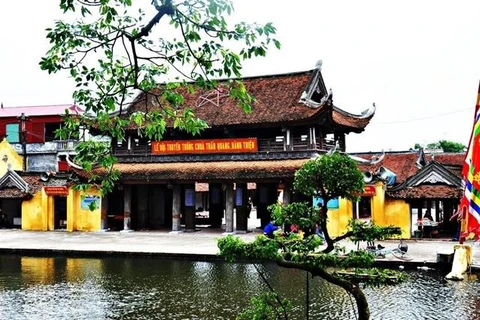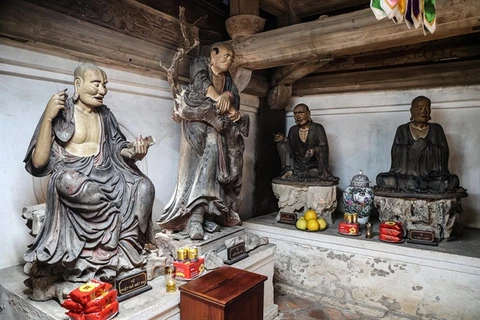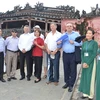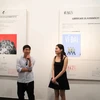 The ancient statues in Dong Nien pagoda are hundreds of years old, boasting value in terms of culture, history, and sculpture. (Photo: Manh Minh/VNA)
The ancient statues in Dong Nien pagoda are hundreds of years old, boasting value in terms of culture, history, and sculpture. (Photo: Manh Minh/VNA) Hanoi (VNA) - The complex of Dong Nien Communal House and Pagoda in Hai Duong city of the northern province of Hai Duong, built in the sixth century, is an ancient architecture with a system of delicate sculptures showing the talent of senior artisans.
With unique and ancient folk-art architecture, Dong Nien communal house is not only a historical and cultural relic but also a spiritual tourist destination in Hai Duong city.
Located in Viet Hoa ward, Hai Duong city, the cluster of Dong Nien communal house and pagoda was ranked as a National Historic Site in 1994.
Dong Nien Pagoda was built in the Later Le Dynasty and restored in the years 1800, 1924. Experiencing changes in history, the relic site still preserves precious artifacts.
Over hundreds of years, Dong Nien communal house and pagoda remains a spiritual address associated with the ups and downs of local people’s lives. On the 10th day of the third lunar month every year, the people of Dong Nien organize a big festival to commemorate the merits of the village’s tutelary gods.
 With unique and ancient folk-art architecture, Dong Nien communal house is not only a historical and cultural relic but also a spiritual tourist destination in Hai Duong city. (Photo: Manh Minh/VNA)
With unique and ancient folk-art architecture, Dong Nien communal house is not only a historical and cultural relic but also a spiritual tourist destination in Hai Duong city. (Photo: Manh Minh/VNA) Nguyen Tien Thanh, Head of the Management Board of Monuments of Viet Hoa Ward, Hai Duong City, said the relics of Dong Nien communal house and pagoda still preserve the system of antiquities including the system of ancient statues, legends, bells, ancient stone, and stone steles.
Notably, in Dong Nien pagoda, there are still 38 statues, of which three are made of earth. All three Buddha statues are dated to the Late Le Dynasty, 18th century.
According to Thanh, despite hundreds of years which at times brought war, the system of artifacts and antiquities in communal houses and pagodas remain almost intact.
In 1964, many statues from Linh Quyet ancient temple (outside the dike) were dismantled and the artifacts transferred to Dong Nien pagoda for worship. The move also caused some statues to be lost. In the past, the statue system also had minor damage such as some statues being loose, losing legs, arms or seats. The locality promptly hired workers to restore them.
Thanh said that, recently, with the desire to restore the ancient Linh Quyet temple, local people built a temporary temple on the old pagoda’s foundation.
Some statues in Dong Nien pagoda, which belonged to Linh Quyet pagoda before, have also been moved here for worship. Local people hope that the competent authorities will pay attention to create conditions for the restoration of Linh Quyet ancient temple to meet the needs of local people’s religious activities. At the same time, this project also aims to better protect the system of artifacts and statues here.
In order to preserve and promote the monuments and artifacts, according to a representative of the City’s Culture and Information Office, it is necessary to do a good job of managing the relics.
After more than 1,000 years, Dong Nien communal house still retains its rare ancient features. The communal house was classified as a national historical relic in 1994. To commemorate the merits of the village’s tutelary god, every year, local people take his birthday (March 10) as the village’s festival.
At the festival, many rituals and various folk games are orgainsed, attracting a large number of people and visitors from far and wide./.






















